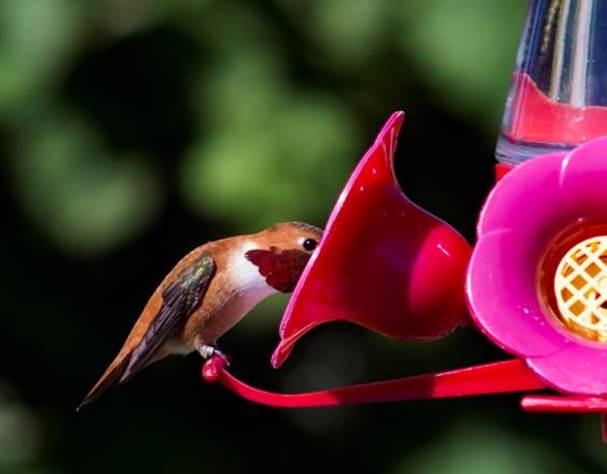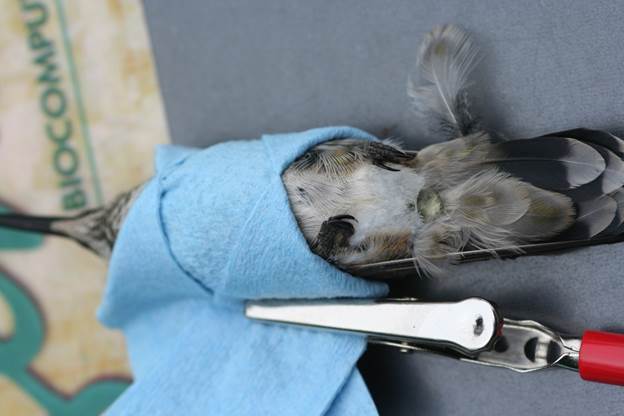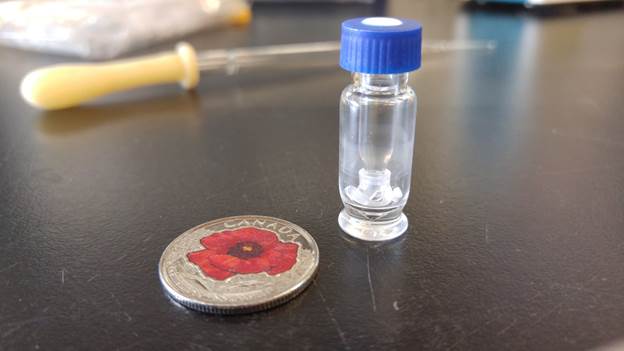Small and feisty Rufous Hummingbirds in British Columbia are getting some hands-on and high-tech help in the hope of finding answers to their population decline.
Data from Canada’s Breeding Bird Survey show that numbers of Rufous Hummingbirds have declined about 50 per cent since the 1970s. This is in stark contrast to all other hummingbird species, whose numbers are increasing.
Dr. Christine Bishop, a research scientist at Environment and Climate Change, is in her second year of a five-year project to help pinpoint reasons for the Rufous Hummingbird’s population decline.
Highly territorial, the brilliant orange males and green-and-orange females are loved by many birders. Rufous Hummingbirds often display and nest in hedgerows near farmlands. Their rapid flight is fueled mainly by nectar supplemented with insects. Their movements between flowers act to pollinate many plants.
Despite weighing less than 4g, Rufous Hummingbirds migrate thousands of kilometers each year. They breed the farthest north of any hummingbird species. The centre of their breeding distribution is in British Columbia and they overwinter in Central America.

“There is not one thing about this hummingbird that is not absolutely awesome,” said Dr. Bishop. “The way their tongues fork and curl up to pump nectar from flowers; the way their feathers refract light, which gives their feathers their dazzling metallic appearance; their incredibly high metabolism: beating their wings about 50 times a second while they fly backwards; and their aggression – nothing will stop them from getting to their nectar source.”
Although there may be other habitat or migration-related factors that are contributing to the population decline of Rufous Hummingbirds, many scientists are concerned about the effects of a new group of insecticides called neonicotinoids, which have been implicated in the declines of another type of pollinator: honeybees.
“Neonicotinoids are insecticides which are relatively persistent, but not as persistent as the ones used in the past,” Dr. Bishop said. “These insecticides have low toxicity to people and are effective on insects. Because they are fat- and water soluble, and are therefore absorbed into plants, we wanted to look at whether Rufous Hummingbirds could be exposed to them through nectar in berry flowers.”
To assess neonicotinoid exposure in hummingbirds, Dr. Bishop is working with colleagues within ECCC: Dr. John Elliott and Dr. Scott Wilson. She is also working with Michelle Toshack, a graduate student in Dr. Elizabeth Elle’s lab at Simon Fraser University, and with Dr. Alison Moran of Rocky Point Bird Observatory. They are examining a range of natural and agricultural sites (blueberry fields) in the Fraser Valley.

Detecting neonicotinoids in hummingbird urine: When banding hummingbirds, Dr. Bishop’s research team takes samples of clear beads of urine (cloacal fluid) and/or fecal pellets produced from each bird.
Analyzing neonicotinoids at low concentrations in very small volume urine samples is a tricky business, and this is where France Maisonneauve, a chemist at the National Wildlife Research Centre, contributed her expertise. Ms. Maisonneuve developed methods using a Liquid Chromatography Mass Spectrometre, which enabled her to detect neonicotinoid insecticides in just a few drops of hummingbird urine.

This injection vial’s tiny glass insert contained a pool of many hummingbird urine samples from the same location to test for neonicotinoids.
The combined total concentration of three neonicotinoid insecticides was just over three parts per billion in samples from hummingbird urine collected from birds living within 0.5 to 1 km of conventionally-sprayed blueberry fields.
“At this stage we know neonicotinoid levels in the hummingbirds are higher than we expected. We hope to look at metabolic rates – heart rates, breathing rates and oxygen rates – in the future,” said Dr. Bishop.
Dr. Bishop will present this first phase of research on neonicotinoids in Rufous Hummingbirds at the World Congress SETAC conference in Orlando, Florida, in November 2016.
